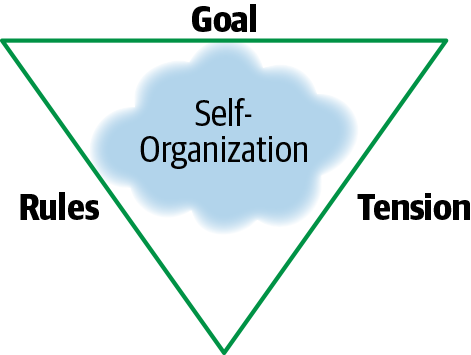Chapter 87. The Triangle of Self-Organization
Andy Brandt

The idea of self-organizing teams is at the core of contemporary approaches to managing complex work. However, it’s still frequently misunderstood as something anarchic, that will just happen if we let it, needing neither attention nor guidance. In reality, productive self-organization within a group, one that supports the purpose for which the group was formed and helps it transform into a team, occurs only if certain conditions are met.
The triangle of self-organization identifies three key conditions influencing group self-organization: goal, rules, and tension. Managing self-organizing teams is done indirectly, mostly through those three elements. Of course, this is assuming that there is no imposed structure (roles, manager), and the group is actually free to self-organize.

Figure 87-1. The triangle of self-organization
To self-organize, the group must have a clear goal that everyone is aware of. This goal shapes the process—different goals require different skills and methods. A shared goal is also the difference between a group and a team—to become a team, the group needs a goal around which to coalesce.
The goal can be implied, but it is more effective if it is openly stated. Shorter, more concise goals are easier ...
Get 97 Things Every Engineering Manager Should Know now with the O’Reilly learning platform.
O’Reilly members experience books, live events, courses curated by job role, and more from O’Reilly and nearly 200 top publishers.

